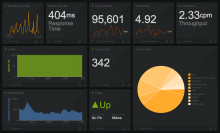Challenge
All good business improvement begins with an understanding of reality. If you're really going to improve some function or operation in your organization, you first need to know where it stands right now. This means you need to know which dimensions of assessment are important or indicative. And, since trends are important, it's best if these dimensions are quantitative and easily obtainable. Beyond even this, you also need to know how each of those metrics compares to its goal. After all, a number by itself is neither good nor bad. It obtains value only when it is compared to its goal. Unfortunately, for many organizations, knowing a little of these metrics is difficult, never mind knowing them all.
Solution and Benefits
You can't improve what you can't measure. More than that, you can't really assess a metric unless you know how it compares to its goal. In addition, for metrics to be actionable, they should be simple, clear, and targeted. They should allow for "drilling down" into more metrics to get information. Dashboard metrics in particular should be indicative. That is, they should give you a quick overview of reality and how it compares to your goals. Our solution for dashboards and metrics is to provide you (and your team, etc.) with a handful of highly important numbers and charts. These will give you a quick orientation to your day. They will tell you what to worry about, and just as importantly, what not to worry about.
Approach
Implementing a dashboards or analytics solutions involves these steps:
- First, we work with you to understand your organization and gather your requirements.
- Then, we create the tool to suit these needs.
- Once this is complete, we can help you rollout the system to your organization.
Gathering Requirements and Planning
First, we work with you to understand your organization and gather your requirements. and then adapting our best practices to meet your individual needs. This takes several steps:
- Review current marketing and sales analytics-We like to review anything we can to learn about 1) what's important to the various groups served by the solution and 2) how they are measuring their success now. This can include interviews, observation, and reading documentation.
- Refine or redesign the the Key Performance Indicators (KPIs)-if your KPIs need to be rethought, we can compare your current operations to our best practices library. This allows us to provide you with proven, high performing systems while preserving what's unique about your organization.
- Discuss goals and plans with the teams and leadership-Before we implement anything, we need everyone. We want to make sure we are making a plan that will work for your organization.
This phase assumes that everything "works", so it serves as much as a roadmap for training as for for the rest of the work. Once this phase of the work is complete, you will have a good understanding of what needs to get implemented and why.
Installing and Configuring
With the documented future state in hand, we can create the dashboard to suit these needs. Depending on the requirements, this can mean several different kinds of work:
- Finding ways to gather metrics from various systems-sometimes a good dashboard requires data from many sources. Or, it requires different metrics to be combined before display. In these cases, we introduce a data warehouse (like in Macroscope).
- Integrating metrics into a dashboarding tool (e.g. Synaxis Macroscope, Geckoboard, etc.)-Here, the various screens and displays are connected to the data.
- Preparing different views for different audiences-Based on the various users, we configure and setup their particular views of the data.
Rolling Out
Once this is complete, we can help you rollout the system to your organization. This means much more than just "flipping the switch". Rather, we make sure that the right teams have the right documentation. Beyond that, we can provide live, online, or hands-on training for teams or individuals. When we do training, we like to record the session. This allows these events to be assets for future on-boarding of marketing and sales staff. Once training is complete, we can track and monitor adoption and offer revised documentation or refresher training, as needed.
